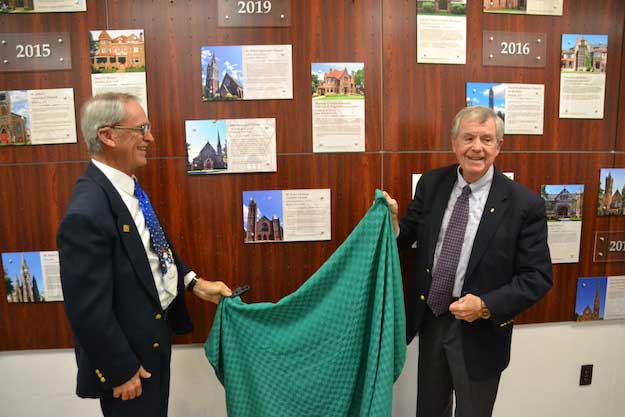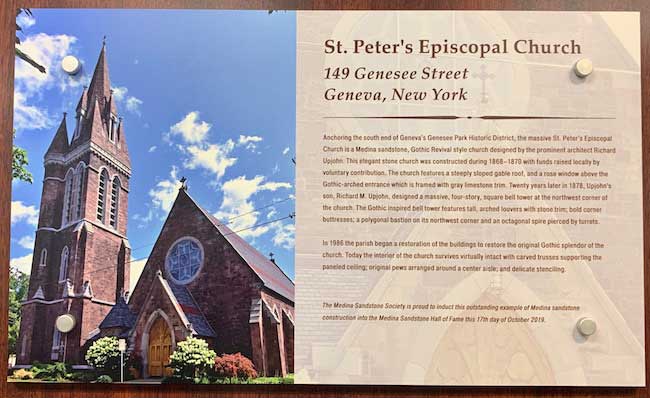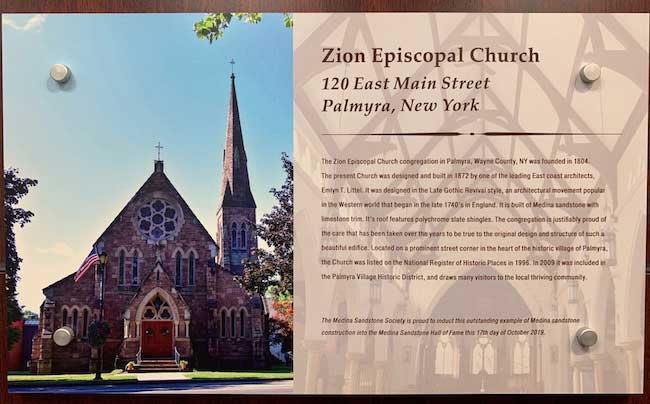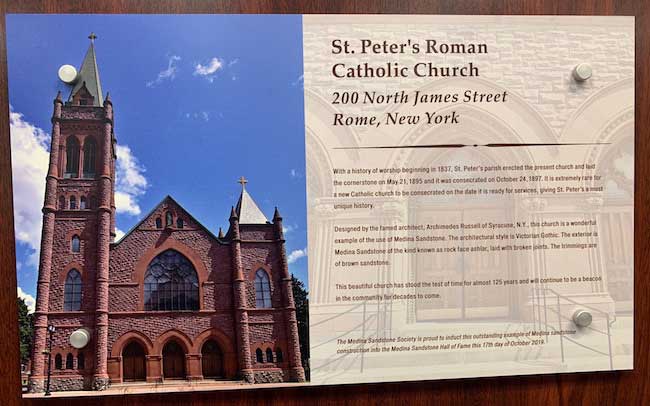4 more sites added to Medina Sandstone Hall of Fame
Mansion in Erie, churches in Palmyra, Geneva and Rome, NY added to distinguished list
MEDINA – The Medina Sandstone Hall of Fame inducted a mansion in Erie, Pa. and three upstate churches into the shrine for spectacular sandstone structures.
Since the hall of Fame was established in 2013, the inductees now include 29 sites and 59 nominations.
Representatives from the four new Hall of Fame sites attended an induction program on Thursday afternoon at Medina City Hall, where the Hall of Fame is located in the main meeting room.
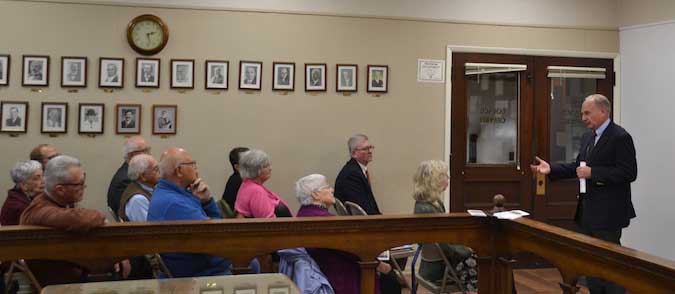
David Miller, president of the Sandstone Society, thanked the buildings’ owners for their care of the structures, which were all built before 1900. The group is sitting by a wall with photos of past Medina mayors.
Jim Hancock, David Miller and Don Colquhoun are all members of the Hall of Fame Committee. They travelled 700-800 miles to visit the sites.
“You have all lovingly taken care of these wonderful sandstone buildings,” Hancock said. “I can guarantee none of you were there when they were built.”
The new inductees have tackled ambitious restoration projects to keep the buildings going for years to come.
“We’re very proud of you for maintaining your buildings,” Hancock told them honorees.
The 2019 Hall of Fame Class includes (with the writeups from the Sandstone Society):
St. Peter’s Episcopal Church, 149 Genesee St., Geneva, NY
Anchoring the south end of Geneva’s Genesee Park Historic District, the massive St. Peter’s Episcopal Church is a Medina sandstone, Gothic Revival style church designed by the prominent architect Richard Upjohn. This elegant stone church was constructed during 1868-1870 with funds raised locally by voluntary contribution.
The church features a steeply sloped gable roof, and a rose window above the Gothic-arched entrance which is framed with gray limestone trim. Twenty years later in 1878, Upjohn’s son, Richard M. Upjohn, designed a massive, four-story, square bell tower at the northwest corner of the church. The Gothic inspired bell tower features tall, arched louvers with stone trim; bold corner buttresses; a polygonal bastion on its northwest corner and an octagonal spire pierced by turrets.
In 1986, the parish began a restoration of the buildings to restore the original Gothic splendor of the church. Today the interior of the church survives virtually intact with carved trusses supporting the paneled ceiling; original pews arranged around a center aisle; and delicate stenciling.
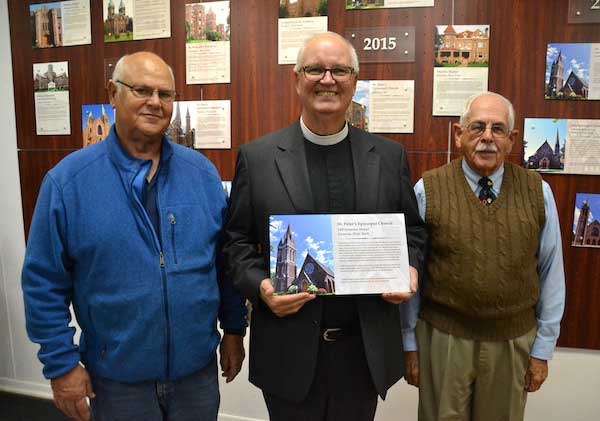
Representatives from St. Peter’s Episcopal Church in Geneva include Joseph Marino, the Rev. Jim Adams and Charles Bauder. Marino and Bauder are long-time members of the church.
Zion Episcopal Church, 120 East Main St., Palmyra
The Zion Episcopal Church congregation in Palmyra, Wayne County, was founded in 1804. The present church was built in 1872 by one of the leading East coast architects, Emyln T. Little. It was designed in the Late Gothic Revival style, an architectural movement popular in the Western world that began in the late 1740s in England.
It is built of Medina sandstone with limestone trim. It’s roof features polychrome slate shingles. The congregation is justifiably proud of the care that has been taken over the years to be true to the original design and structure of such a beautiful edifice.
Located on a prominent street corner in the heart of the historic village of Palmyra, the church was listed on the National Register of Historic Places in 1996. In 2009, it was included in the Palmyra Village Historic District, and draws many visitors to the local thriving community.
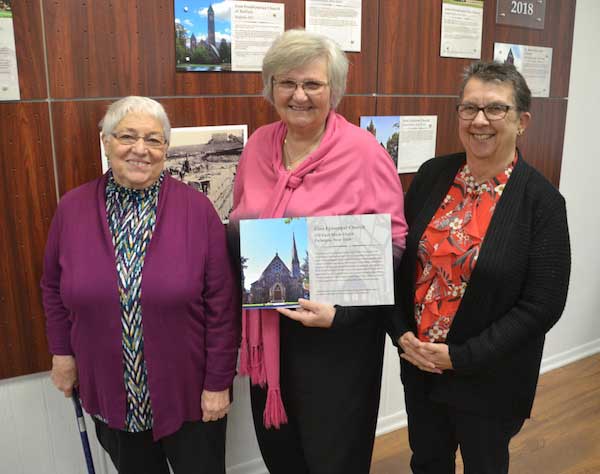
The Zion Episcopal Church in Palmyra was represented at the induction ceremony by church members, from left: Cindy Lehmkuhl, Elaine Bonafede and Diane Peters. Bonafede and Peters are members of the vestry. Lehmkuhl serves in the church’s archives committee with Bonafede.
St. Peter’s Roman Catholic Church, 200 North James St., Rome
With a history of worship beginning in 1837, St. Peter’s Parish erected the present church and laid the cornerstone on May 21, 1895 and it was consecrated on Oct. 24, 1897. It is extremely rare for a new Catholic church to be consecrated on the date it is ready for services, giving St. Peter’s a most unique history.
Designed by the famed architect, Archimedes Russell of Syracuse, this church is a wonderful example of the use of Medina sandstone. The architectural style is Victorian Gothic. The exterior is Medina sandstone of the kind known as rock-face ashlar, laid with broken joints. The trimmings are of brown sandstone.
This beautiful church has stood the test of time for almost 125 years and will continue to be a beacon in the community for decades to come.
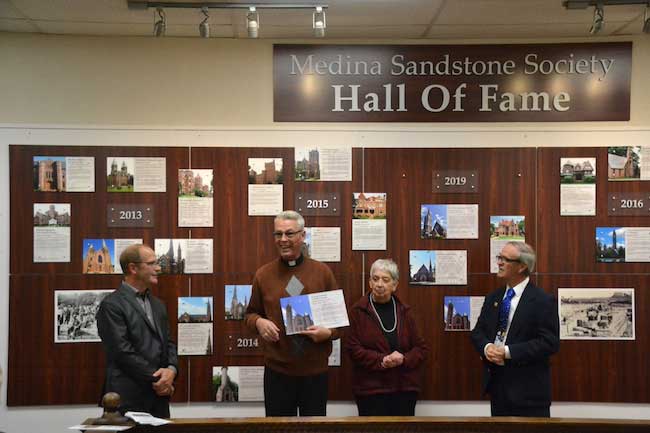
Representatives of St. Peter’s Roman Catholic Church in Rome thanked the Hall of Fame Committee for the recognition. Father Sean O’Brien praised the church’s parishioners and a previous priest for a big restoration project at the church in 2005. Father O’Brien is joined by the church’s maintenance director, Mark LaGasse, and office manager, Sharon Hansen. Jim Hancock is at right.
Watson-Curtze Mansion (Thomas B. Hagen History Center), 356 West 6th St., Erie, Pa.
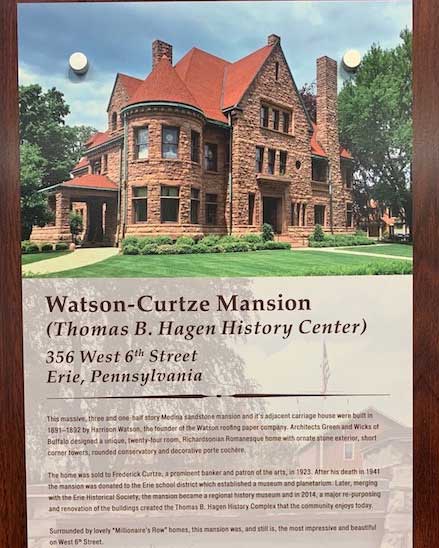
Architects Green and Wicks of Buffalo designed a unique, 24-room, Richardsonian Romanesque home with ornate stone exterior, short corner towers, rounded conservatory and decorative porte cochere.
The home was sold to Frederick Curtze, a prominent banker and patron of the arts, in 1923. After his death in 1941, the mansion was donated to the Erie school district which established a museum and planetarium.
Later, merging with the Erie Historical Society, the mansion became a regional history museum and in 2014, a major repurposing and renovation of the buildings created the Thomas B. Hagen History Complex that the community enjoys today.
Surrounded by lovely “Millionaire’s Row” homes, the mansion was, and still is, the most impressive and beautiful on West 6th Street.
Since the Hall of Fame was established in 2013, 29 sites have been inducted and 59 have been nominated.
Other sites nominated in 2019, but not yet inducted, include: Eberhardt Mansion in Buffalo, Blessed Sacrament Roman Catholic Church in Buffalo, Trinity Episcopal Church in Buffalo, Old Stone Warehouse/Skalny Building in Rochester, St. Ann Catholic Church in Erie, Pa.; and St. Paul Catholic Church in Erie, Pa.
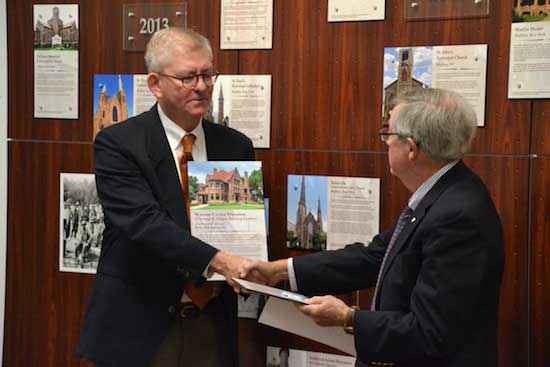
Jeff Sherry, museum educator at the Historical Society of Erie County, accepts the award for the Thomas B. Hagen History Center, a new member of the Medina Sandstone Hall of Fame. He is congratulated by Don Colquhoun of the Sandstone Society.






























